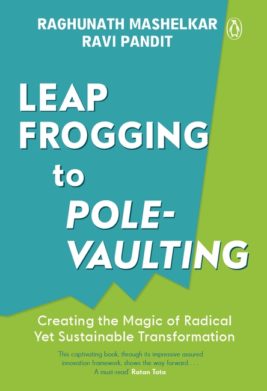LEAP FROGGING to POLE-VAULTING
Featured
LEAP FROGGING to POLE-VAULTING
Reviewed by Mr. Sushil Bahl, Life Member
Non-Fiction
Publisher: Penguin Random House India, New Delhi
Price: INR 599
To review a book by prominent personalities, professionals, and global innovators like Raghunath Mashelkar (former Director General of CSIR) and Ravi Pandit (Chairman of KPIT Technologies), is indeed a task, and a privilege!
In the earlier days of Indian and global economies it was the concept of “leap frogging” into change, progress and growth that was prevalent. Today, according to the authors, it is the need for the concept of “pole-vaulting” into the future! An innovative framework to the way forward, and creating the magic of radical yet sustainable transformation.
The innovative 3-4-7 Framework
The metaphor by the authors has been spelt out practically a unique 3-4-7 innovation framework, or formula, which shows us way forward, by Pole-vaulting over insurmountable obstacles for radical and sustainable transformation!
- The 3 Es — Energy, Environment and Employment.
Energy and its ever increasing demand, and the skewed politics of supply! The need for making for renewable forms of energy towards better quality of industry, and the life of people. The environment and its misuse. Possible future extinction of air, water, species and minerals. Gloom or doom? Employment — jobs for everyone?
within the need for “assured” technological innovations today.
2. The 4 Levers – in step with each other!
Technology – its accelerating pace, today. Progress and impact! Freedom to be creative and innovative. It is believed that with technology nothing is impossible today! Public Policy – a delicate balancing act. At the Marketplace and Socialplace! Its influence and all round reforms and successful implementation.
Social engagement – the power of people. Movements and revolution! Universality of values. By the people, for the people! Its about simple leaders with high thinking!
The Economic model – doing it, doing good! Requiring successful solutions – reducing costs and increasing value. Here Government help is essential for innovation. A sustained policy push to do good! CSR 1 to CS 2, as described by the authors.
3. The 7 Elements – in respect of Scalability, Sustainability, and Universality. All in the Indian context first, and global as well!
To elaborate upon and explain their framework, or formula, the authors have dwelled into two interesting and illustrative Indian case-studies offering new learning and ideas in the concept of real life Pole-Vaulting for notable developments.
First, about today’s new “Clean Revolution” in respect of the Solid Waste Management programme by KPIT and the Maratha Chamber of Commerce, Pune. Which is about managing unimaginable quantity and undesirable quality of solid waste (including plastic).
Second, about today’s new “Green Revolution” in the form of mobility and transportation for transformation! Concerning the Indian automotive sector – in production, technology and employment.

Pole-Vaulting Leaders!
The authors in the book go on further to tell the readers about how to create pole-vaulting leaders in organisations. Leaders with a mindset which is radical and transformational, and adoptable by them! Non-conventional and proactive attitude to do things that work. Fuelling pole-vaulting spirit within organisations, through a compelling vision and mission, ideas and projects, and not waiting for “Godot” (messiah). Being overall game changers!
Using the framework for solving problems – small or big and complex! In practice and actions for assured success, in the present and future. Reactive to Pro-active! For a new economic order and development!
With some creative solutions, concerning the major and widespread developmental issues the book, containing innovative ideas and concepts is easy to read, and go through.
It is certainly worth a read.
